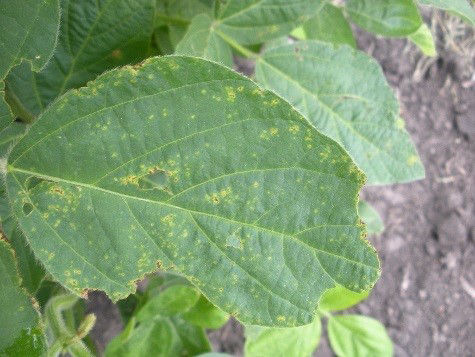A Guide to Common Soybean Diseases in The South
February 23, 2021
To learn more about identification and management of soybean disease and nematodes - click on a tab.
Sources:
Fungus foliage diseases of soybeans. PPD N. 503. 1990. Reports on Plant Diseases. Integrated Pest Management. https://ipm.illinois.edu/.
Thomas-Murphy, J. Alternaria leaf spot. Diseases of Soybeans. Field Crops. Cornell University. https://fieldcrops.cals.cornell.edu/.
Geisler, L.J. Anthracnose. CROPWATCH. University of Nebraska – Lincoln. https://cropwatch.unl.edu/.
Malvick, D. Anthracnose on soybean. University of Minnesota. https://extension.umn.edu/.
Kelly, H.M. and Stewart, S. Soybean rust. Institute of Agriculture. The University of Tennessee https://guide.utcrops.com.
Smith, D. Asian soybean rust. Wisconsin Field Crops Pathology. University of Wisconsin. https://fyi.extension.wisc.edu/.
Coker, C., Hurst, K., Kirkpatrick, T., Rupe, J., Tingle, C., and Trent, M. 2005. Asian soybean rust. FSA7531. Agricultural and Natural Resources. University of Arkansas. https://www.uaex.edu.
Malvick, D. 2018. Bacterial blight of soybean. University of Minnesota. https://extension.umn.edu/.
Faske, F., Kirkpatrick, T., Zhou, J., and Tzanetakis, I. 2014. Soybean diseases. Arkansas Soybean Production Handbook. Chapter 11. University of Arkansas. https://www.uaex.edu/.
Faske, F., Kirkpatrick, T., Zhou, J., and Tzanetakis, I. 2014. Soybean diseases. Arkansas Soybean Production Handbook. Chapter 11. University of Arkansas. https://www.uaex.edu/.
Giesler, L.J. Bacterial pustule. CROPWATCH. University of Nebraska. https://cropwatch.unl.edu./.
Giesler, L.J. Bean pod mottle virus. CROPWATCH. University of Nebraska. https://cropwatch.unl.edu.
Malvick, D. Bean pod mottle virus on soybean. University of Minnesota. https://extension.umn.edu/.
Smith, D. Bean pod mottle virus. Wisconsin Field Crops Pathology. University of Wisconsin. https://fyi.extension.wisc.edu/.
Westphal, A., Abney, T.S., and Shaner, G. 2006. Brown stem rot. Diseases of Soybean. BP-41-W. Purdue University. https://www.extension.purdue.edu/.
Kelly, H.M. and Stewart, S. Cercospora leaf blight. Institute of Agriculture. The University of Tennessee https://guide.utcrops.com.
Hershman, D.E. 2009. Cercospora leaf blight in Kentucky. Plant Pathology Fact Sheet. PPFS-AG-S-20. University of Kentucky. https://plantpathology.ca.uky.edu.
Smith, D. 2014. Cercospora leaf blight and purple seed stain of soybean. Wisconsin Field Crops Pathology. University of Wisconsin. https://fyi.extension.wisc.edu/.
Melvick, D. 2018. Charcoal rot on soybean. University of Minnesota Extension. https://extension.umn.edu/.
Hershman, D.E. 2011. Charcoal rot of soybean. Plant Pathology Fact Sheet. PPFS-AG-S-02. University of Kentucky. http://plantpathology.ca.uky.edu.
Soybean pod and stem blight. Integrated Crop Management. Iowa State University. https://crops.extension.iastate.edu/.
Malvick, D. 2018. Stem canker on soybean. University of Minnesota Extension. https://extension.umn.edu/.
Kleczewski, N. 2017. Stem canker on soybeans. Field Crops Disease Management. http://extension.udel.edu/.
Kelly, H.M. and Stewart, S. Downy mildew. Institute of Agriculture. The University of Tennessee https://guide.utcrops.com.
Faske, T. and Kirkpatrick, T. Downy mildew of soybean. University of Arkansas. https://www.uaex.edu.
Kelly, H.M. and Stewart, S. Frogeye leaf spot. Institute of Agriculture. The University of Tennessee https://guide.utcrops.com.
Faske, T. 2016. Soybean disease update and management: Frogeye leaf spot. University of Arkansas. http://www.arkansas-crops.com/.
Nelson, B. Fusarium root rot. Soybean Diseases. North Dakota State University. https://www.ndsu.edu/.
Thomas-Murphy, J. Fusarium wilt. Field Crops. Cornell College of Agriculture and Life Sciences. https://fieldcrops.cals.cornell.edu/.
Soybean management guide. Clemson University. https://scsoybeans.org/.
Padgett, G. Nematode management in soybean. Louisiana State University. https://www.lsuagcenter.com/.
Mulrooney, R.P. 2011. Soybean cyst nematode. PP-02. University of Delaware. https://extension.udel.edu/.
Sisson, A. Phyllosticta leaf spot. Integrated Crop Management. Iowa State University. https://crops.extension.iastate.edu/.
Phyllosticta leaf spot of soybean. Crop Protection Network. https://cropprotectionnetwork.org/.
Malvick, D. 2018. Phytophthora root and stem rot on soybean. University of Minnesota. https://extension.umn.edu/.
Smith, D. Phytophthora root and stem rot. Wisconsin Field Crops Pathology. University of Wisconsin. https://fyi.extension.wisc.edu/.
Zitnick-Anderson, K., Markell, S., and Nelson, Jr., B. 2014. Pythium damping-off of soybean. PP1737. https://www.ag.ndsu.edu.
Allen, T. 2012. Soybean seedling disease identification: Pythium damping-off and root rot. Mississippi Crop Situation. Mississippi State University. http://www.mississippi-crops.com.
Padgett, B. 2011. Red crown rot. Root & Lower Stem Diseases. Soybean Disease Atlas. LSU AgCenter. Louisiana State University. https://www.lsuagcenter.com/.
Scott, K. and Dorrance, A. 2017. Rhizoctonia damping-off and root rot of soybeans. Ohioline. The Ohio State University. https://ohioline.osu.edu/.
Kelly, H.M. and Stewart, S. Brown spot. Institute of Agriculture. The University of Tennessee https://guide.utcrops.com.
Faske, T. and Kirkpatrick, T. Brown spot of soybean. University of Arkansas. https://www.uaex.edu.
Kleczewski, N. 2017. Southern blight in soybeans. Field Crops Disease Management. University of Delaware. https://extension.udel.edu/.
Faske, T. and Kirkpatrick, T. Southern blight of soybean. University of Arkansas. https://www.uaex.edu/.
Zhou, J. and Tzanetakis, I.E. Soybean mosaic virus. University of Arkansas. https://www.uaex.edu.
Mueller, D. 2013. Soybean vein necrosis virus identified in Iowa. Integrated Pest Management. Iowa State University. https://crops.extension.iastate.edu/.
Byamukama, E., Dorrance, A., Jardine, D., Malvick, D., Markell, S., Nachappa, P., Sisson, A., and Sweets, L. 2015. Soybean vein necrosis virus. Soybean Disease Management. CPN-1003. Crop Protection Network. www.soybeanresearchinfo.com/.
Zhou, J. and Tzanetakis, I.E. Soybean vein necrosis virus. University of Arkansas. https://www.uaex.edu/.
Kelly, H.M. and Stewart, S. Southern stem canker. Institute of Agriculture. The University of Tennessee https://guide.utcrops.com.
Spurlock, T. 2015. Sudden death syndrome of soybean found. Arkansas Row Crops. University of Arkansas. http://www.arkansas-crops.com.
Kelly, H.M. and Stewart, S. Target leaf spot. Institute of Agriculture. The University of Tennessee https://guide.utcrops.com.
Faske, T. and Kirkpatrick, T. Target spot of soybean. University of Arkansas. https://www.uaex.edu.
Zhou, J. and Tzanetakis, I.E. Tobacco ringspot virus. University of Arkansas. https://www.uaex.edu.
Malvick, D. 2018. Sclerotinia stem rot (white mold) on soybean. University of Minnesota Extension. https://extension.umn.edu.
Smith, D. White mold of soybean (Sclerotinia stem rot). Wisconsin Field Crops Pathology. University of Wisconsin-Madison. https://fyi.extension.wisc.edu.
(Sources verified 6/2019), 1007_G2


